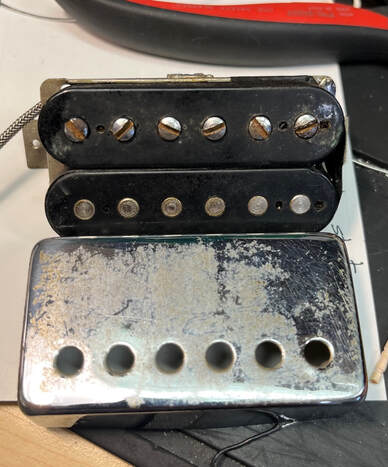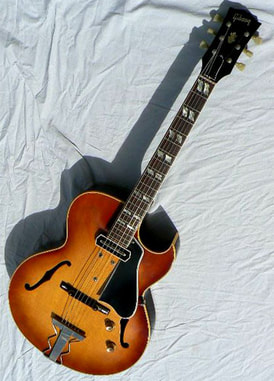 1965 PAF spec Patent # Pickup.
1965 PAF spec Patent # Pickup. I just finished up another vintage P.A.F. pickup repair today. This time it was a P.A.F. spec Patent # pickup likely dating from 1965. This era of Gibson humbucker is essentially a P.A.F., however with a chrome plated cover and chrome plated pole screws and the white and black start and finish wires typically indicating no internal start lead. In all other respects this era of pickup mirrors the same specs as a late short magnet P.A.F., butyrate bobbins, short Alnico 2 magnet, plain enamel magnet wire and the wire pitch, or turn per layer count, that matches the variations of PAF sticker pickups. The similarities with a PAF sticker pickup have made these ever more desirable in the used market for those seeking vintage PAF tones with a somewhat lower price point.
The pickup pictured required a screws coil rewind. Screw coils in even a covered humbucker are the most likely to fail internally as they are vulnerable to sweat, beer, whatever liquid that enters the square hole next the E string adjustable pole screw. Like with all rewind candidates I unwind the coil by hand in search of a possible wire break and also to establish the turn per layer count of the coil so we can choose the correct wire pitch and machine so the rewound coil will have all the properties of the damaged original coil.
However while unwinding this original coil it became apparent that the turn per layer did match any of the the wire pitch data we have from our vintage PAF, Patent # or even T-Top repair records. Knowing the coil was 100% original, I figured there must be a simple explanation for a wire pitch setting so far outside of our repair records data. With a little thought I posited that the wire pitch for this pickup 42awg wire pickup was likely the same wire pitch as the wire pitch for a 38 awg Charlie Chrisitian pickup. With a quick test on the ThroBak Meteor ME-301 coil winder I confirmed that the pickup in need of a rewind, was in fact wound at the 38 awg setting on the Meteor ME-301, (just an FYI for any pickup makers reading this, the 38awg setting on the ME-301 is not what you would expect for 38 awg wire).
The pickup pictured required a screws coil rewind. Screw coils in even a covered humbucker are the most likely to fail internally as they are vulnerable to sweat, beer, whatever liquid that enters the square hole next the E string adjustable pole screw. Like with all rewind candidates I unwind the coil by hand in search of a possible wire break and also to establish the turn per layer count of the coil so we can choose the correct wire pitch and machine so the rewound coil will have all the properties of the damaged original coil.
However while unwinding this original coil it became apparent that the turn per layer did match any of the the wire pitch data we have from our vintage PAF, Patent # or even T-Top repair records. Knowing the coil was 100% original, I figured there must be a simple explanation for a wire pitch setting so far outside of our repair records data. With a little thought I posited that the wire pitch for this pickup 42awg wire pickup was likely the same wire pitch as the wire pitch for a 38 awg Charlie Chrisitian pickup. With a quick test on the ThroBak Meteor ME-301 coil winder I confirmed that the pickup in need of a rewind, was in fact wound at the 38 awg setting on the Meteor ME-301, (just an FYI for any pickup makers reading this, the 38awg setting on the ME-301 is not what you would expect for 38 awg wire).
 1965 ES-175 with factory intalled Charlie Christian pickup.
1965 ES-175 with factory intalled Charlie Christian pickup. So the question is why in the world Gibson have the ME-301 winding machine set to 38 awg wire in 1965? Well it is because Gibson occasionally made custom runs of Charlie Christina pickups, even in 1965. Here is a photo one such example of a 1965 ES-175 with a factory installed Charlie Christian pickup. So for some period of time the 38 awg setting remained long enough to wind this PAF spec Patent # pickup before being dialed back to the correct 42awg setting for a humbucker. Are there more out there? Probably, and when one comes across my repair bench I'll know the reason for the winding pattern.
This repair illustrated just one more example of some of the interesting variations in vintage PAF pickups over the years. The difference in wire pitch with this vintage Gibson humbucker being repaired will likely give it a bit of an airier tone than the same pickup with the "typical" PAF or Patent # wire pitch variations. Now to ship off this latest pickup repair to the lucky owner.
Jon Gundry
This repair illustrated just one more example of some of the interesting variations in vintage PAF pickups over the years. The difference in wire pitch with this vintage Gibson humbucker being repaired will likely give it a bit of an airier tone than the same pickup with the "typical" PAF or Patent # wire pitch variations. Now to ship off this latest pickup repair to the lucky owner.
Jon Gundry

 RSS Feed
RSS Feed

